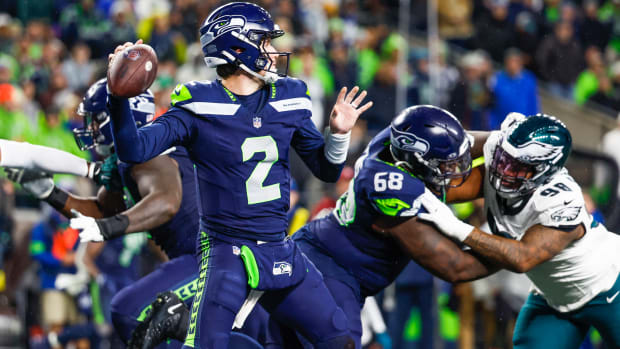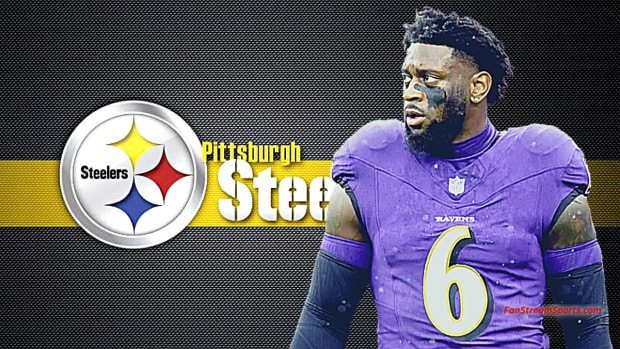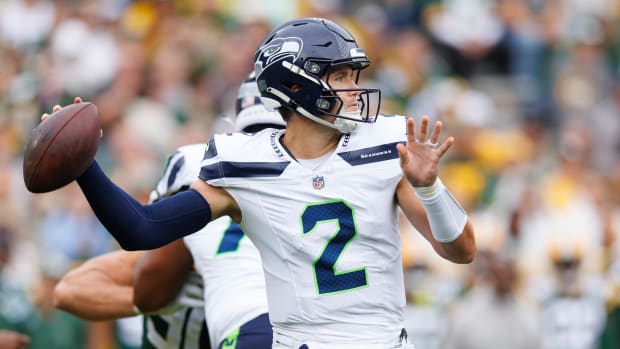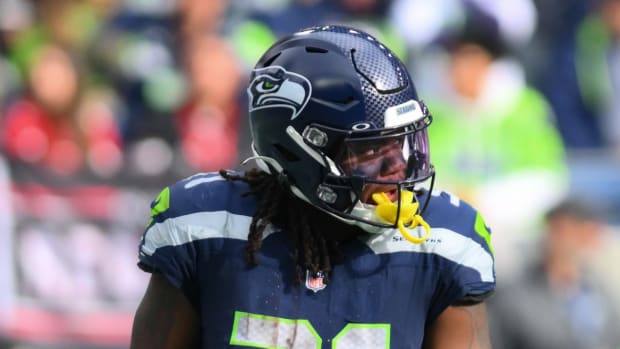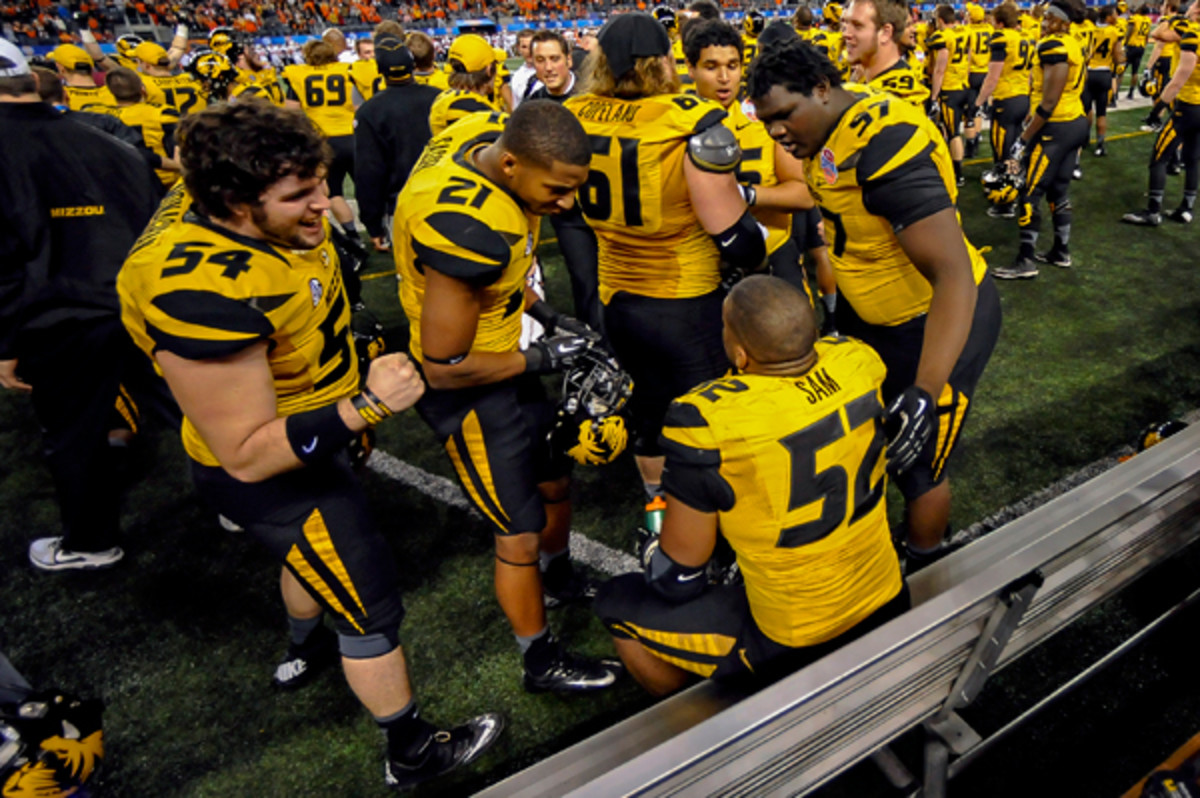
Combine storylines to watch: Defense
Michael Sam had the support of his college teammates. Will life in the NFL be the same? (Cal Sport Media via AP Images)
From Thursday through next Tuesday, the entire NFL, the whole of the football media and as many draft prospects as one can fit into Indianapolis' Lucas Oil Stadium will participate in the annual event known as the scouting combine. This is where teams start to get firm beads on prospects, and those prospects can impress in all sorts of ways. Here are a few storylines to watch in this year's version -- from the defensive side of things.
How will the Michael Sam story continue?
In all the combines I've covered (this will be the eighth), there were two player press conferences that stood out from a pure circus perspective. There was the Tim Tebow interview session in 2010, when several reporters broke their own 40-yard dash records getting to the podium (and probably suffered hamstring injuries in the process), and the Manti T'eo mashup last year, where the reporters were safe from injury re-aggravations because T'eo showed up late -- no doubt due to a large amount of last-minute coaching and deprogramming. We all fed like jackals on Tebow's combination of wholesomeness and potential (read: alleged) NFL talent, just as we all went for the jugular on T'eo's odd catfishing tale.
MORE COVERAGE: Latest Mock | Combine storylines: Offense | Complete draft coverage
This combine will have an equally buzzy story, but the treatment and narrative will be far different. When Missouri defensive end Michael Sam steps to the podium on Saturday, Feb. 22, he'll do so as the first-ever openly gay draft prospect. And while the media will maintain a respectful dialogue for the most part, there's always room in an open forum for some really inappropriate stuff. So, there's that.
As for Sam's actual football measurables, NFL teams will finally move beyond their boilerplate statements regarding gay players in the league and look at what kind of player he can be at the next level -- and that's when things will become more interesting and honest. The SEC Co-Defensive Player of the Year is currently NFLDraftScout.com's 11th-ranked end, which is in line with where most analysts put him -- as a third-day player based on pure talent alone. Sam has been working on his measurables pre-combine, as all invited players will have been, but for a 6-foot-2 pass-rusher with speed in the 4.7 range, he'll answer a lot of questions with the combine field drills he does next Monday.
Sam will be asked to fire off the snap, to dip and rip, to show his agility in different ways, and to try to separate himself from a lot of game tape that comes off ... well, unfortunately average. No doubt Sam will handle himself well when we're all firing questions at him, but the real story is what happens when he goes under the lights at Lucas Oil. It will all be about the game then and his place in it.
Can Jadeveon Clowney prove himself to be best player?
It's not hyperbolic to say that before the 2013 NCAA season, South Carolina defensive end Jadeveon Clowney was thought to be the surefire No. 1 prospect in the 2014 draft class. Had certain Byzantine rules allowed him to declare after his second season in 2012, there's a pretty good chance he would have gone in the top-three overall in last year's draft. But things are what they are -- and for Clowney, there are now the questions about his motivation, his motor and his overall production.
That's what happens when your sack totals go from eight to 13 to three and your tackles for loss move from 12 to 23.5 to 12.5 as Clowney's did in his three collegiate campaigns. The tape shows that opposing teams were putting as many blockers on Clowney in 2013 as they possibly could, but that was also the case in 2012. Clowney also played through the 2013 season with a foot injury, and though there are no plans for surgery, the combine medical examination is obviously a huge deal. Clowney will be the undercard to Michael Sam at the podium and on the field, and the perceptions of him may be just as difficult to shake in some quarters. For some in the NFL, Clowney is a "natural talent" who hasn't put in the work to bring his God-given ability to full boil.
“He's a modern-day Randy Moss,” one AFC East scout recently told NFLDraftScout.com's Dane Brugler about Clowney. “J.C. doesn't have the same type of criminal background as Randy did when he was his age, but the dependence on natural talent and problematic effort concerns are very similar. Difference is, Clowney won't fall out of the top-seven like Randy did.”
And then, there's Houston Texans owner Bob McNair's recent take on Clowney, which put forth some interesting code words.
“He is a remarkable player," McNair told the team's official website last month. "He’s one of these players that’s really a once-in-every-10-years kind of physical specimen that comes along ... He’s not a J.J. Watt,” McNair said. “You know, J.J. didn’t have that natural ability. He worked. He developed his [abilities]. And one of the things I said to J.J., I said, ‘J.J., I don’t know what will happen, but if we get Clowney, we want you to instill in him the same kind of work habits that you have.’ He said, ‘If he’s in the same room with me, then he’ll have them.’”
Of course, Watt was also a ridiculously athletic player when he was a draft prospect at Wisconsin, but perceptions are what they are. Clowney has said that it's his goal to run a 4.4 40-yard dash on the track in Indy, and if he's able to pull that off at 6-5 and 275 pounds, you can bet that McNair will change his tune. At a certain point, even ... umm ... "natural" athletes are so over the top that you just have to overlook your manufactured concerns.
[si_video id="video_1278CEFE-40AA-7ECF-D13F-1CC2B3B43CA5" height="475"]
Will more NFL teams look to copy Seattle's defensive blueprint?
Coaches and executives from 31 NFL teams got a good, hard look at the league's new defensive modus operandi when the Seattle Seahawks crushed the Denver Broncos 43-8 in Super Bowl XLVIII. The most prolific offense in NFL history (from a points perspective, at least) was rendered utterly helpless by the Seahawks' combination of speed, size and overwhelming power.
Head coach Pete Carroll and general manager John Schneider built that defense over four years, and only defensive tackle Brandon Mebane is still in that locker room from the pre-Carroll days. But you can bet there will be teams looking for that one huge cornerback or outsized cover linebacker or oddball rotational defensive lineman with the thought that their defense is just a few pieces away.
Certainly, anyone taking even a cursory look at the Senior Bowl rosters noticed that the defensive backs were bigger, and there are more of them playing aggressive press coverage at the college level these days. It's something that Carroll addressed at last year's combine, and it's something you'll hear out of the mouths of other coaches and GMs in the days to come.
"Really, the decision for me was like 20 years ago. So this didn't just happen -- we happened to hit two big, long, tall guys at the same time," Carroll said of cornerbacks Richard Sherman and Brandon Browner. "When you're a bump-and-run oriented group and that's part of the mainstay of your philosophy, you realize that the length that guys have at the line of scrimmage is a big asset. Some guys have long arms, and some guys have the broad shoulders and big wingspans and all, but when you put together guys that are 6-3 and 6-4 and they have all of that, it just makes for a larger target for them at the line of scrimmage, so the receivers have to go a longer ways to get around them. That's as fundamental as that is, really."
The days of the average Cover-2 cornerback at 5-10 leading the way are coming to an end. But what's interesting about this combine class is that none of the elite pass-defenders stand over six feet. That includes Michigan State's Darqueze Dennard, Oklahoma State's Justin Gilbert and TCU's Jason Verrett. So maybe it will be up to the lower-ranked guys, such as Nebraska's Stanley Jean-Baptiste and Utah's Keith McGill (both of whom should measure in at around 6-3) to fill that particular mold. Sherman was a fifth-round pick out of Stanford, after all ...
Can LB class shake out as one of the best ever?
Luke Kuechly in 2011 notwithstanding, the average inside linebacker will not find his name called in the first round of a draft these days. That tells us two things: Kuechly is anything but average, and the position itself has been devalued a bit in recent years. But in 2013, Alabama's C.J. Mosley has a very good shot at the top 10, because he's a pure 360-degree player with outstanding field instincts and tackling fundamentals. And he's not the only linebacker who could go in the first half of the first round.
Look at anyone's Big Board and you're likely to see Buffalo's Khalil Mack and UCLA's Anthony Barr -- both outside linebackers -- right up near the top, and for good reason. Starting with the combine and moving into their pro days and private workouts, other linebackers (Ohio State's Ryan Shazier, BYU's Kyle Van Noy and Utah's Trevor Reilly among them) will be trying to bull their way into the first round as well. Last season, just two linebackers went in the first round -- Jarvis Jones to the Steelers with the 17th pick, and Alec Ogletree to the Rams at 30. Both players were Georgia alums, but the range of playmakers at the linebacker position looks to be far more global this time around.
Which players will rise from the (relatively) unknown?
Every year, the combine will feature a few small-school gems who rise up from anonymity for various reasons. Last year, Arkansas-Pine Bluff offensive tackle Terron Armstead made waves by running a 4.65 40-yard dash at 6-5 and 306 pounds. The word was already out on Armstead in NFL front offices based on his strong tape and performance at the East-West Shrine Game, but that one quick run gave him a much bigger presence in the public eye. The Saints took Armstead in the third round, and he started the last four games of the season for New Orleans, including two playoff games.
This year, look out for these small-schoolers on the defensive side of the ball:
DE Ethan Westbrooks, West Texas A&M: Led his team with 19.5 tackles for loss, and made first-team All-Conference.
DE Larry Webster, Bloomsburg: The former basketball star lit up the Shrine Game with his quickness and athleticism. He needs to pack on some NFL-level muscle, but he'll light up the combine drills.
DT Justin Ellis, Louisiana Tech: Ellis used both the Shrine Game and Senior Bowl to show that he could match up with the best collegiate offensive linemen. The combine is the next step for a guy who could sneak into the second day of the draft.
DT Jamie Meder, Ashland: A tackling machine at lower levels who impressed at the NFLPA Collegiate Bowl. Scouts have been following him around for a while.
ILB Andrew Jackson, Western Kentucky: Jackson didn't need any postseason bowl weeks to let the world know that he had SEC talent -- offensive players from several SEC teams who played Western Kentucky could have told you that already.
OLB Howard Jones, Shepherd: It's hard to get national attention when you're balling out in the Mountain East, but this Cliff Harris Award finalist has earned the looks he'll get at the combine. In 2013, he amassed eight sacks, 12.5 tackles for loss, two forced fumbles and a fumble return for a touchdown.
CB Pierre Desir, Lindenwood:

































